
Sergeeva_Ivanova_IMPROVE_YOUR_PRONUNCIATION
.pdf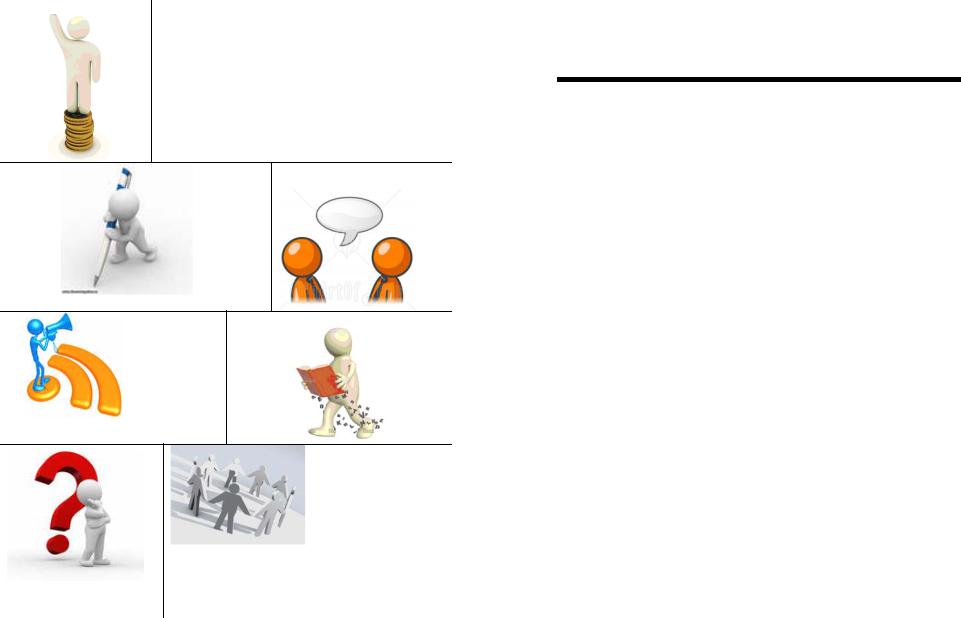
IMPROVE YOUR PRONUNCIATION
STUDENT’S BOOK
N.SERGEYEVA E. IVANOVA
ДЕПАРТАМЕНТ ОБРАЗОВАНИЯ И МОЛОДЕЖНОЙ ПОЛИТИКИ ХАНТЫ-МАНСИЙСКОГО АВТОНОМНОГО ОКРУГА – ЮГРЫ
_______________________________
ГОУ ВПО «СУРГУТСКИЙ ГОСУДАРСТВЕННЫЙ УНИВЕРСИТЕТ ХАНТЫ-МАНСИЙСКОГО АВТОНОМНОГО ОКРУГА – ЮГРЫ»
Н.Н. Сергеева Е.А. Иванова
IMPROVE YOUR
PRONUNCIATION
STUDENT’S BOOK
Учебно-методическое пособие по практической фонетике
для студентов факультета лингвистики
Сургут Издательский центр СурГУ
2010
1
УДК 811.111’34(072) ББК 81.2Англ-1-923
С 322
Печатается по решению редакционно-издательского совета СурГУ
Рецензенты
кандидат филологических наук, доцент кафедры методики преподавания английского языка
и перевода СурГУ И.А. Курбанов
Сергеева Н. Н.
С 322 Improve Your Pronunciation. Student’s Book : учеб-метод. по-
собие по практической фонетике для студ. фак-та лигвистики / Н. Н. Сергеева, Е. А. Иванова ; Сургут. гос. ун-т ХМАО – Югры. – Сургут : ИЦ СурГУ, 2010. – 95 с.
Настоящее пособие представляет собой краткий курс практической фонетики для студентов факультета лингвистики, самостоятельно совершенствующих навыки владения английским произношением.
Книга для студента включает основной материал по практической фонетике английского языка и может быть использована как для самостоятельной работы над произношением, так и для проведения вводнокоррективного фонетического курса на гуманитарных факультетах.
УДК 811.111’34(072) ББК 81.2Англ-1-923
©Сергеева Н.Н., Иванова Е.А., составление, 2010
©ГОУ ВПО «Сургутский государственный университет ХМАО – Югры», 2010
2
CONTENTS
FOREWORD ……………………………………………………………. |
4 |
Preparation strategies ………………………………………………..… |
6 |
Six steps to achieve perfect pronunciation |
|
Breathing exercises |
|
Articulation exercises |
|
Organs of speech |
|
STEP I: Manifestation of English Sounds …………………………..… |
9 |
Consonant production |
|
Vowel production |
|
Combinations that are hard tо pronounce |
|
Sound clusters practice |
|
STEP II: Reading Rules ……………………………………………...… 50 Strategies for work with reading rules
Letters reading rules Syllable types Reading practice
STEP III: Connected speech………………………………………….… 65 Strategies for work with assimilation
Assimilation types Assimilation exercises
STEP IV: Rhythm works …………………………………………….… 71 Strategies for work with rhythm
Rhythmic groups
Geographical names memorizing Reading poetry
STEP V: Intonation…………………………………………………...… 82 Basic tones in English intonation
Utterance description strategies
STEP VI: Intonation Styles …………………………………………..… 85 Strategies for work with rhythm
Intonation styles practice Conversational (familiar) style Informational style Publicistic or oratorical style Academic (scientific) style Declamatory (artistic)
BIBLIOGRAPHY …………………………………………………….… 94
3
FOREWORD
ПРЕДИСЛОВИЕ
Настоящее учебно-методическое пособие представляет собой сокращенный вводно-коррективный курс практической фонетики английского языка, предназначенный для студентов факультетов лингвистики. Оно может быть использовано для самостоятельной работы в совершенствовании произносительного навыка студентами старших курсов. Пособие построено в соответствии с базовой программой по курсу практической фонетики для студентов факультетов лингвистики.
Пособие состоит из семи разделов, первым из которых является подготовительный, предлагающий дыхательные и артикуляционные тренировочные упражнения для подготовки к работе. Шесть основных разделов построены с учетом базовых понятий английской фонетики, таких как гласные и согласные звуки, словесное и фразовое ударение, ассимиляция, адаптация, элизия, ритм, мелодика речи, интонационные контуры и интонационные стили.
Упражнения построены с учетом основных трудностей, которые испытывают студенты при овладении английским произношением: некоммуникативные (артикуляционные, оппозиционные, ударения, акцентуации, правил чтения); коммуникативные (ритма, интонации, эмоциональной установки, дискурсивные); организации самостоятельной работы (выбора задач, алгоритма работы, анализа навыка).
Каждый раздел сопровождается рекомендациями для самостоятельной работы и алгоритмами работы над тем или иным заданием, которые дают возможность студенту автономно работать над совершенствованием произносительного навыка.
Поскольку курс предназначен для студентов уже имеющих базовый произносительный навык, работа с аудиоподдержкой начинается с третьего раздела, в котором предлагаются аудио записи для проверки выполненных заданий, а также записи отрывков из художественных произведений, стихов классических английских авторов, речей известных политиков и детских песен. Основное внимание уделяется коррекции индивидуальных ошибок в различных аспектах, развитию и закреплению интонационно-ритмического оформления фраз и текстов.
Учебно-методическое пособие дополнено рабочей тетрадью. В рабочей тетради предлагаются упражнения для закрепления основных фонетических понятий и навыков, а также упражнения, развивающие творческий потенциал студентов. В рабочей тетради предлагаются также отрывки из классических произведений английских авторов, сопровождающиеся аудио и видеозаписями.
4
Структура пособия проста и единообразна и позволит проработать материал как в полном объеме в указанной последовательности, так и выборочно, в любой удобной для преподавателя и студента последовательности.
5

PREPARATION
STRATEGIES
SIX STEPS TO ACHIEVE PERFECT PRONUNCIATION
1.Imagine that you are talking to English native speaker as if you are speaking your native language.
2.Remember that you can speak English. You’ve made a great progress! It’s time to step ahead.
3.Remember that you have much to learn. Never be sure your pronunciation is already perfect, even if you are one of the best students. Try to find your weak points, pronunciation requires perfection.
4.Use any opportunity to speak. The more you speak the more you want to speak.
5.Discuss every successful step and failure with your friends.
6.Try to discuss dull and laborious topics. The more you speak about boring things the less boring and tiring they seem to be.
BREATHING EXERCISES
Breathing exercises are very important as they help you to prepare for hard work with non adapted articulation of English sounds. Breathing regulates blood pressure, heart rate, circulation, digestion and many other bodily functions that help us to speak. Breathing gives an excellent tool to help facilitate communication. Moreover, deep breathing helps relieve nervous energy; it helps develop a strong voice and helps to strengthen personal intensity. It is important for our energy, our focus, and our concentration.
Breathing exercises are necessary to set up your voice and prepare you for long and intensive work with foreign language pronunciation. Exercises provide flexibility, self-control and lightness of your breath.
Preliminary exercise
Stand in up-right position with your spine straight; put your shoulders back and hands on your stomach. Remember to check shoulders; they should not be going up, and your stomach should be going out. It is best to breathe in through your nose and breathe out through your mouth, as the tiny hairs and mucous membranes filter out dust and toxins from the inhaled air. Repeat each exercise for 5 or 7 times.
6
Exercise 1
Breathe out to release your lungs; make a short loud breath and push out the air with the help of diaphragm that you can hear the sound of your breath.
Exercise 2
Breathe out to release your lungs; make a long deep breath to fill tour lungs with the air then make a long breath out with the help of diaphragm. Breath out is longer than breath in.
Exercise 3
Breathe out to release your lungs; make the alteration of shot loud and long deep breaths.
Exercise 4
Breathe out to release your lungs; make a long deep breath and then breathe out with the obstacle pronouncing sound [p – p – p].
Exercise 5
Breathe out to release your lungs; make a long deep breath and then breathe out with the obstacle pronouncing sound [b – b – b].
Exercise 6
Breathe out to release your lungs; make a long deep breath and breathe out with the obstacle pronouncing sound [m – m – m].
Final exercise
Sigh deeply, letting out a sound of deep relief as the air rushes out of your lungs; let new air come in naturally. Repeat this procedure five or seven times whenever you feel the need for it, and experience the feeling of relaxation.
ARTICULATION EXERCISES
Now, you can get to articulation training. In speaking articulation refers to the art of expressing yourself in a lucid and logical manner. It is a pronunciation feature that merges all your articulatory organs together in order to shape the sounds of foreign language. You should use a small mirror to see your mouth in order to control its movement.
Preliminary exercise
The tongue plays a big part in shaping the sounds you make and the words you speak. Focus on the tongue. Utter the alphabet A – utter it in such a larger than life manner, that your face breaks into a smile. When that happens, focus on your tongue – you will notice that it is minimally touching your teeth on both sides. Practice these articulation exercises and you will gain tongue control. Repeat each exercise 5 or 7 times.
7

Exercise 1
Shut your mouth; stretch your lips as much as possible to feel slight tension; relax your lips.
Exercise 2
Open your mouth a little; stretch your lips as much as possible to feel slight tension; relax your lips.
Exercise 3
Open your mouth; push your tongue over a lower jaw; imagine you’re keeping a ping-pong ball in your mouth; relax your lips.
Exercise 4
Open your mouth as much as possible; pull your tongue out; make a “lion yawn”; relax your mouth.
Exercise 5
Open your mouth as much as possible; pull your tongue out and move it from extreme right side to extreme left side of your mouth; relax your mouth.
Exercise 6
Shut your mouth; make “a kiss” movement to feel slight tension; relax your lips.
Exercise 7
Shut your mouth; make “a kiss” movement; make a right-hand and then a left-hand circle; relax your lips.
ORGANS OF SPEECH
1 – hard palate
2 – alveolar ridge
3 – upper lip
4 – upper teeth
5 – lower lip
6 – lower teeth
7 – front part of the tongue
7a – tip of the tongue
8 – mid part of the tongue
9 – back part of the tongue
10 – root of the tongue
11 – vocal cords
12 – soft palate
13 – uvular
14 – pharynx I – Mouth Cavity 15 – larynx II – Nose Cavity
8
STEP I
MANIFESTATION OF ENGLISH SOUNDS
CONSONANT PRODUCTION
The processes involved in the production of English consonants may be looked at from two angles: manner and places of articulation. Place or point of articulation is the point at which the air from the lungs is either interrupted totally or partly, and is modified in the vocal tract to produce a sound. Scholars identify seven places of articulation in the production of English consonants. These are labial, labiodental, dental, alveolar, palatal, velar, and glottal. Manner of articulation refers to the manner in which the airflow in the vocal tract is modified by the speech organs in the production of a sound. Scholars identify two classes of consonant: occlusive, in the production of which a complete obstruction is formed and constrictive, in the production of which an incomplete obstruction is formed.
VOWEL PRODUCTION
There should be also good knowledge of the processes involved in the production of vowels in English. Vowels pose greater difficulty to the second or foreign language learners of English, especially because of certain complex relations between them, stress, and the production of diphthongs.
In the production of a vowel sound there is no interruption whatsoever of the airflow in the speech tract and there is no audible friction either.
Four criteria are generally employed in the identification and description of vowels. 1. Lip rounding/unrounding, that is, the kind of opening made at the lips, the degrees of lip rounding or spreading. 2. Tongue height, that is, the extent to which the tongue rises in the direction of the palate. 3. The part of the tongue that is raised: front, center, or back. 4. The position of the soft palate which is raised for the production of oral vowels, and which is closed for the production of nasalized vowels
It is also important to note whether a vowel is tense or lax and whether a vowel is accompanied by another vowel-like sound which together forms a diphthong. In some cases it is important to note the length of the vowel produced.
9
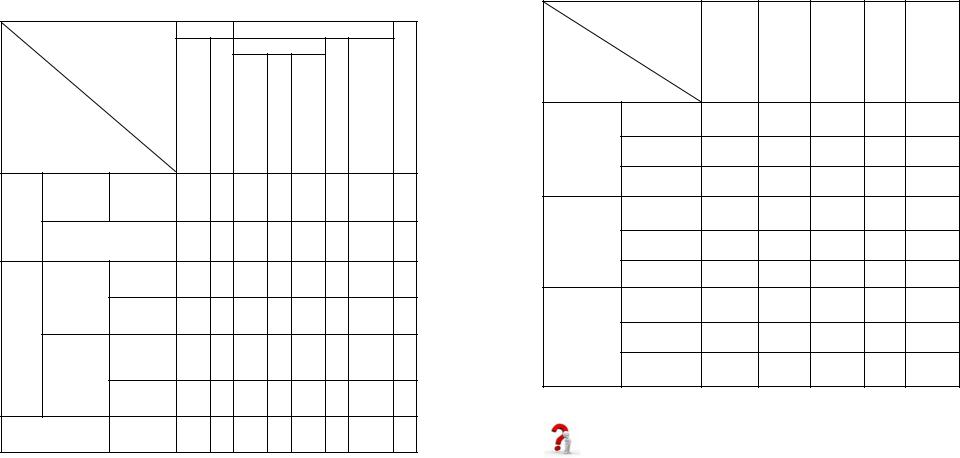
TABLE OF CLASSIFICATION OF CONSONANTS
|
Place of articulation |
Labial |
|
|
Lingual |
|
|
|||
|
|
|
|
|
Forelingual |
|
Backlingual (Velar) |
|
||
Type of |
|
|
Labio-dental |
|
Alveolar |
Post alveolar |
Midiolingual |
|
||
obstruction |
|
Bilabial |
Dental |
Glottal |
||||||
and manner |
|
|||||||||
of noise production |
||||||||||
|
|
|
||||||||
Occlusive |
Fricative |
PlosIve |
p |
|
|
t |
|
|
k |
|
b |
|
|
d |
|
|
g |
|
|||
|
|
|
|
|
|
|
||||
Nasal |
m |
|
|
n |
|
|
N |
|
||
|
|
|
|
|
|
|||||
|
|
|
|
|
|
|
|
|||
|
Fricative |
Flat |
|
f |
T |
S |
|
|
|
|
c t I v e |
|
v |
D |
Z |
|
|
|
h |
||
|
|
|
|
|
||||||
Rounded |
|
|
|
s |
|
|
|
|
||
|
|
|
z |
|
|
|
|
|||
r I |
|
Lateral |
|
|
|
|
|
|
|
|
C o n s t |
Sonorant |
|
|
|
|
|
|
|
|
|
approxi- |
|
|
|
l |
|
|
|
|
||
mant |
|
|
|
|
|
|
|
|||
|
|
|
|
|
|
|
|
|||
MIddle |
w |
|
|
|
r |
j |
|
|
||
|
|
|
|
|
|
|
||||
|
Affricates |
FrIcatIve |
|
|
|
G |
|
|
|
|
|
|
|
|
C |
|
|
|
|
||
|
|
|
|
|
|
|
|
|
|
|
TABLE OF CLASSIFICATION OF VOWELS
10
|
Tongue |
|
|
|
|
|
|
|
movement |
Front |
Front retracted |
Central |
Back |
Back ad- |
vanced |
|
|
||||||
Tongue position |
|
|
|
|
|
|
|
|
HIgh |
I: |
|
|
H |
|
|
Close |
Mid |
|
I |
|
|
u |
uq |
|
|
Iq |
|
|
|
|
|
|
Low |
|
|
|
|
|
|
|
HIgh |
eI |
|
qu |
|
|
|
Mid |
Mid |
e |
|
W |
|
|
|
|
|
|
|
|
|
|
|
|
Low |
|
|
q |
A |
|
|
|
HIgh |
FE |
aI |
|
OI |
|
|
Open |
Mid |
Qu |
|
|
O: |
|
|
Low |
x |
|
|
P |
Q: |
||
|
|
|
|||||
STRATEGIES FOR WORK
WITH SOUND CLUSTERS
1.Read the description of the sounds. Use dictionary if necessary.
2.Use a mirror to see the position of your organs of speech.
3.Repeat the sound several times. (from 5 to 10)
4.Read the words given after the sound description, focusing your attention on articulation.
5.Use a mirror to see the position of your organs of speech while pronouncing the words.
6.Mind the intensity of your organs of speech.
11
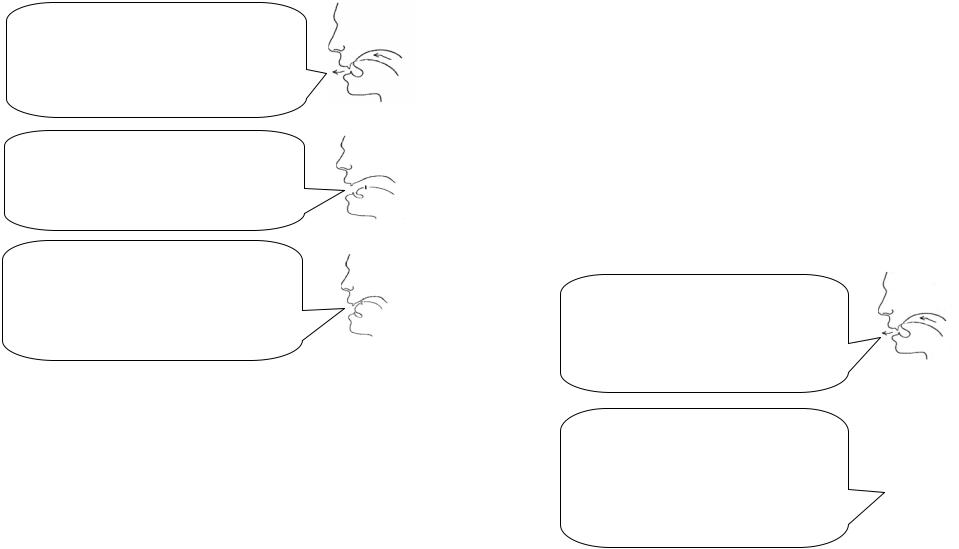
[d] – forelingual, alveolar, occlusive, plosive,
fricative, voiced consonant.
Tongue touches the alveolar ridge to stop air. Then tongue moves away from alveolar ridge to release air and there is a small explosion of air out of the mouth. Vocal cords work.
[I] – front retracted, mid, close unrounded,
short monophthong.
Open the mouth a little. Raise the tongue a little and put it in front part of the mouth cavity.
Lips are spread.
[I:] – front, high, close, unrounded, long diph-
thongoid.
Open the mouth a little. Raise the tongue rather high and put it in front part of the mouth cav ity. Then the tongue goes in the direction of hard palate. Lips are spread.
Read the following phonemic blocks with [d] plus vowel.
[dI] |
[Id] |
[dI:] |
[I:d] |
Did |
Did |
Deed |
Indeed |
Dill |
Disk |
Deem |
Feed |
Dim |
Hid |
Deal |
Read |
Din |
Lid |
Dean |
Lead |
Dig |
Mid |
Deep |
Speed |
Read the following utterances containing clusters of sounds. Use dictionary to translate idioms.
[I]
1.Is Mickey in? ['Iz mIkI "In]
2.It’s this wind. [Its Dis 'wInd]
3.It isn’t cricket. [It 'Iznt 'krIkIt]
4.I think it’s a bit thick. [QI 'TINk Its q 'bIt 'TIk]
12
5. Biddy is quits with Billy. ['bIdI Iz 'kwIts wID 'bIlI]
[I:]
1.Extremes meet. [Ikst'rI:mz 'mI:t]
2.Greek meets Greek. ['grI:k 'mI:ts 'grI:k]
3.A pea for a bean. [q 'pI: fqrq 'bI:n]
4.I’ll treat Jean to peach ice-cream [aIl 'trI:t 'dZI:n tq 'pI:tS 'aIskrI:m]
5.Please be seated. ['plI:z bI 'sI:tqd]
[d]
1.Delays are dangerous. [dI 'leIz q 'dxndZqrqs]
2.Dog does not eat dog. ['dOg dqz 'nOt 'I:t 'dOg]
3.Diamond cut diamond. ['daImqnd 'kAt 'daImqnd]
4.Drop by drop the sea is drained. ['drop baI 'drop Dq 'sI: Iz 'dreInd]
5.Desperate diseases must have desperate remedies. ['despqrqt dI'zI:zqz 'mqst hqv 'despqrqt 'remqdIz]
[t] – forelingual, alveolar, occlusive, plosive,
fricative, voiceless consonant.
Tongue touches the alveolar ridge to stop air. Then tongue moves away from alveolar ridge to release air and there is a small explosion of air out of the mouth. Vocal cords don’t work.
[x] – front, low, open, unrounded, short
monophthong.
Put the tongue in front part of the mouth cavity and press it against the lower teeth. The tip of the tongue is raised a little. The mouth is considerably opened. Lips are spread. Vocal cords don’t work.
Read the following phonemic blocks with [t] plus vowel.
[xt] |
[tæ] |
[tI] |
[tI:] |
Bat |
Tack |
Tick |
Teeth |
Hat |
Tan |
Till |
Team |
|
|
|
13 |
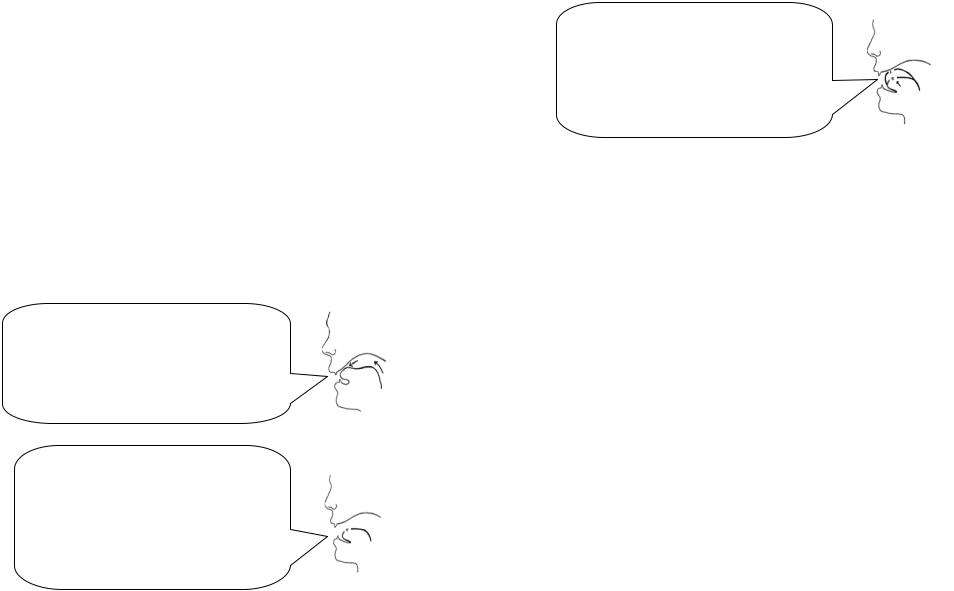
Mat |
Tat |
Tin |
Treat |
Fat |
Tag |
Ting |
Teach |
Flat |
Tap |
Tip |
Tease |
Read the following utterances containing clusters of sounds. Use dictionary to translate idioms.
[t]
1.To return to our muttons. [tq rI'tWn tq Quq 'mAtnz]
2.Mart is as true as steel. ['mRt Iz qz 'tru: qz 'stJl]
3.Ted is a bit of wet blanket. ['ted Iz q 'bIt qv 'wet 'blxnkIt]
4.Better the foot slip than tongue trip. ['betq Dq 'fHt slIp Dqn 'tAN 'trIp]
5.Time and tide wait for no man. ['taIm qnd 'taId 'weIt fq 'nqu 'mxn]
[x]
1.Sam’s acting the ass. ['sxmz 'xktIN Dq 'xs]
2.That’s a bad taxi-cab accident. ['Dxts q 'bxd 'txksI 'kxb 'xksIdent]
3.Hang your hat on the hat-rack. ['hxN jO 'hxt qn Dq 'hxt rxk]
4.Have the man carry the bags to the cabin. [hqv Dq 'mxn 'kxrI Dq 'bxgz tq Dq
'kxbin]
5.He that catches matches hatches catches. ['hI Dxt 'kxCIz 'mxCIz hxCIz
'kxCIz]
[s] – forelingual, alveolar, constrictive,
fricative, rounded, voiceless consonant.
Front part of the tongue is near the alveolar ridge. Air goes through the gap with the noise. Vocal cords don’t work.
[e]– front, mid, open, unrounded, short
monophthong.
Put the tongue in front part of the mouth cavity and remain a small opening between the teeth. The tip of the tongue is pressed against the lower teeth. The mouth is considerably opened. Lips are spread.
14
[eI] – diphthong with a front, mid, short,
unrounded nucleus and [I] – glide.
Put the tongue in front part of the mouth cavity and press the tongue against the lower teeth. Then move the tip of the tongue up to the alveolar ridge to the [I] – position. Lips
are spread
Read the following phonemic blocks with [s] plus vowel.
[se] |
[seI] |
[sI] |
[si:] |
Sell |
Safe |
Sick |
Seal |
Set |
Sail |
Sill |
Seem |
Send |
Sale |
Sin |
Seat |
Said |
Same |
Sip |
Seed |
Slept |
Sane |
Sit |
Seek |
Sledge |
Save |
Skill |
Seize |
[sæ] |
[su] |
[sə:] |
[so] |
Sad |
Soon |
Search |
Sob |
Sack |
Soot |
Serf |
Sod |
Sap |
Sooth |
Serve |
Sop |
Sash |
Soothe |
Surf |
Soft |
Sat |
Soup |
Surge |
Sol |
Read the following utterances containing clusters of sounds. Use dictionary to translate idioms.
[s]
1.Advertisement helps to sell. [qd'vWtIsment 'helps tq 'sel]
2.Precisely so. [pre'sQIslI 'squ]
3.See you soon. ['sI: ju 'sHn]
4.I’m absolutely sertain of success. [aIm 'xbsqlu:tlI 'sq:tn qv sqk'ses]
5.Let’s assume that it’s so. ['lets qs'ju:m Dqt Its 'squ]
[e]
1. Mel meant to get ahead. ['mel 'ment tq 'get q'hed]
15
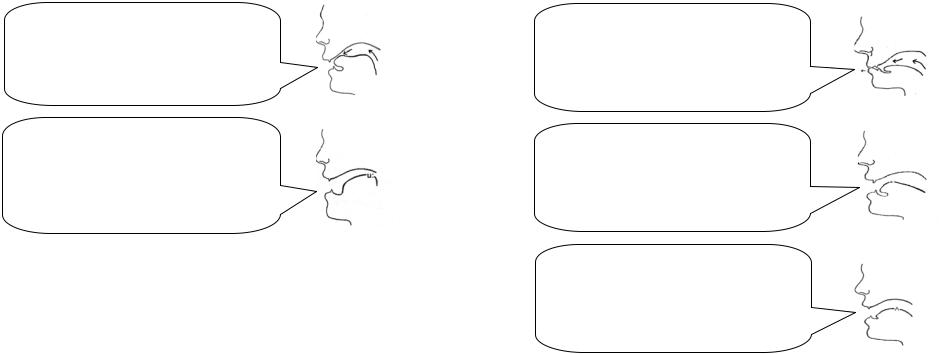
2.Tess’ll never get the better of Ted. ['tesl 'nevq 'get Dq 'betqr qv ted]
3.Meg’s getting very deaf. ['megz 'getIN 'verI 'def]
4.Ned felt better when he’d rested. ['ned 'felt 'betq wen hId 'rested]
5.Deb expects to get ready next Wednesday. ['deb Iks'pekts tq 'get 'redI 'nekst
'wensdI]
[eI]
1.Fay’s afraid she may fail. ['feIz q'freId SI 'meI 'feIl]
2.Small rain lays great dust. ['smLl 'reIn 'leIz 'greIt 'dAst]
3.Gabe’s information came from the stable itself. ['geIbz Infq'meISn 'keIm
frqm Dq 'steIbl It'self]
4.They are playing the waiting game. [DeI q 'pleIN Dq 'weItIn 'geIm]
5.Dale’s at the same little games again. ['deIlz qt Dq 'seIm lItl 'geImz q'geIn]
[z] – forelingual, alveolar, constrictive,
fricative, rounded, voiced consonant.
Front part of the tongue is near the alveolar ridge. Air goes through the gap with the noise. Vocal cords work.
[u:] – back, high, close, long, rounded
diphthongoid.
Raise back part of the tongue to the soft palate. The tip of the tongue is retracted back. The mouth is considerably opened. Lips are slightly rounded.
Read the following phonemic blocks with [z] plus vowel.
[zu:] |
[zI] |
[ze] |
[eIz] |
Zoo |
Zero |
Zebu |
Base |
Zool |
Zink |
Zed |
Lazy |
Zoom |
Zing |
Zest |
Crazy |
Zeus |
Zip |
|
Daisy |
Read the following utterances containing clusters of sounds. Use dictionary to translate idioms.
16
[z]
1.Deeds not words. ['di:dz nqt 'wWdz]
2.Heads or tails? ['hedz q 'teIlz]
3.It goes easier. [It 'gquz 'i:zIq]
4.My reasons are as follows. [maI 'ri:znz qr qz 'fOlquz]
5.As sure as eggs are eggs. [qz 'Suqr qz 'egz qr 'egz]
[H]
1.Sue’s true blue. ['sjHz 'trH 'blH]
2.Ruth can’t say boo to the goose. ['rHT 'kRnt seI 'bH tq Dq 'gHz]
3.The new moon is due. [Dq 'njH 'mHn Iz 'djH]
4.Trudy is too busy doing the rooms. ['trHdI Iz 'tH bIzI 'dHiN Dq 'rHmz]
5.Lou grew too big to the boots. ['lH 'grH 'tH bIg tq Dq 'bHts]
[b] – bilabial, occlusive, fricative, plosive,
voiced consonant.
Lips closed to stop the air. Then lips opens abruptly to let the air out so they make explosion. The vocal cords work.
[q:]– central, mid - open, long, mo-
nophthong.
Put your tongue and jaw in relaxed position. The tongue is in the central position. Lips are relaxed and mouth is half – open.
[A] - back advanced, mid, low, short
monophthong.
Put the back part of your tongue back and front part of the tongue down. Lips are relaxed and mouth is half – open.
Read the following phonemic blocks with [b] plus vowel.
[bə:] |
[bA] |
[bi] |
[bi:] |
17
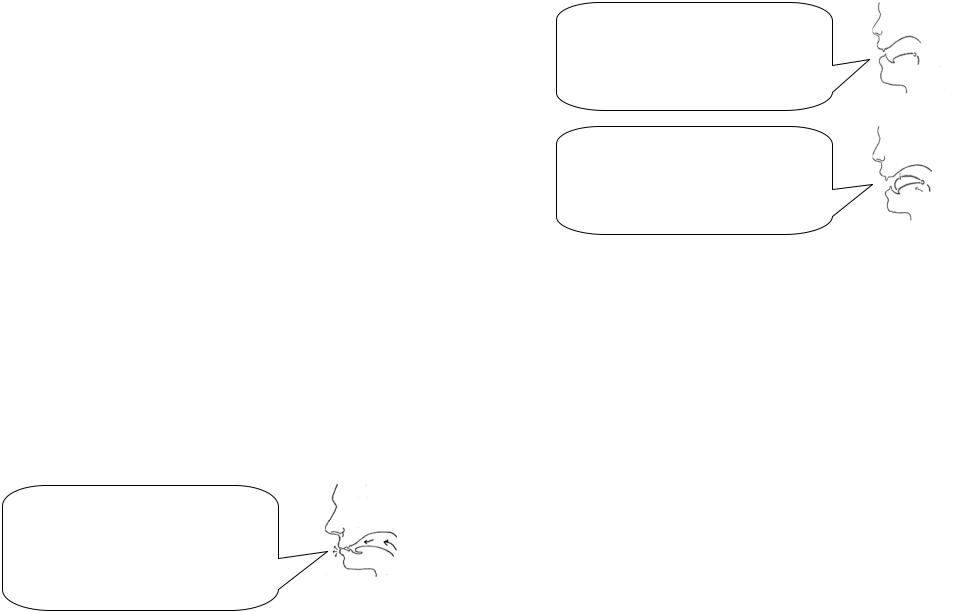
Bird |
Buck |
Big |
Bead |
Burn |
Bud |
Bill |
Beam |
Burst |
Bug |
Bit |
Bean |
Berth |
But |
Bin |
Beast |
Birch |
Bun |
Bid |
Beach |
Burl |
Bus |
Biff |
Breed |
|
Bust |
Bis |
Beat |
Read the following utterances containing clusters of sounds. Use dictionary to translate idioms.
[b]
1.The biter’s bit. [Dq 'bItqz 'bIt ]
2.Ben’s a bag of bones. ['benz q 'bxg qv 'bqunz ]
3.Betty’s as bold as brass. ['betIz qz 'bquld qz 'brRs ]
4.Barbara’s as busy as a bee. ['bRbrqz qz 'bIzI qz q 'bJ]
5.Bob is a big bug. ['bOb Iz q 'bIg 'bAg]
[W]
1.A worm will turn. [ q 'wWm wIl 'tWn]
2.What a hurly-burly girl Urse is! ['wOt q 'hWlI 'bWlI 'gWl 'Wz Iz]
3.I’ll see her further first. [aIl 'sJ hq 'fWDq 'fWst]
4.Bert’s boat turned turtle. ['bWts 'bqut 'tWnd 'tWtl]
5.My girl has her bursts of work. [maI 'gWl hxz{hq 'bWsts qv 'wWk]
[A]
1.Tough luck! Just my luck! ['tAf lAk Gqst 'mQI lAk]
2.Double Dutch! ['dAbl 'dAC]
3.Russ hung up hurriedly. ['rAs 'hAN Ap 'hArIdlI]
4.Lush is nothing but a money-grubber. ['lAS Iz 'nATIN bqt q 'mAnI grAbq]
5.Dug mustn’t worry Justin. ['dAg 'mAsnt 'wArI 'GAstIn]
[p] – bilabial, occlusive, fricative, plo-
sive, voiceless consonant.
Lips closed to stop the air. Then lips opens abruptly to let the air out, so they make explosion. The vocal cords don’t work. The sound is pronounced with aspiration.
18
[O] – back, open, low, rounded, short
monophthong.
Put front part of your tongue down and put the buck of your tongue back a little. Lips are rounded.
[OI] – diphthong with the sort, back,
open, rounded nucleus and [I] – glide.
Put your tongue in back part of the mouth cavity and press the tongue against the lower teeth. Then move the tip of the tongue up
|
Read the following phonemic blocks with [p] plus vowel. |
|
[pO] |
[poI] |
[px] |
Pot |
Poil |
Pat |
Pod |
Poind |
Pack |
Poll |
Point |
Pact |
Pond |
Poise |
Pad |
Pop |
Poison |
Pan |
|
Poit |
Patch |
[pə:] |
[pI:] |
[pI] |
Purse |
Peace |
Pit |
Perk |
Piece |
Pick |
Perm |
Peak |
Pig |
Pearl |
Peel |
Pill |
|
Pea |
Pink |
|
Peach |
Pitch |
Read the following utterances containing clusters of sounds. Use dictionary to translate idioms.
[O]
1.Not for toffees. ['nOt fq 'tOfIz]
2.What a lot of nonsense. ['wOt q 'lOt qv 'nOnsens]
3.Rod wants his coffee strong. ['rOd 'wOnts hIz 'kOfI 'strON]
19
